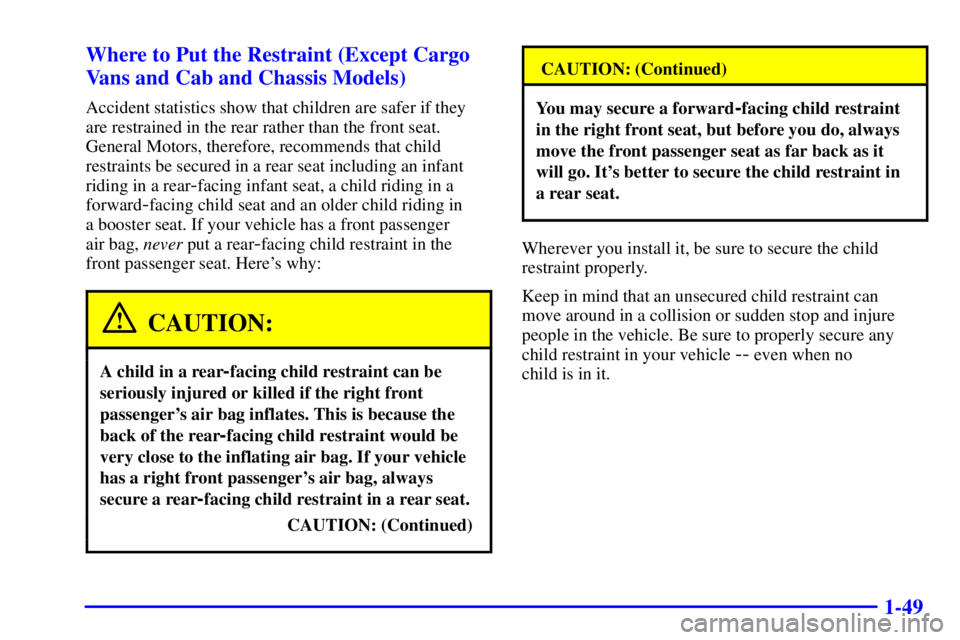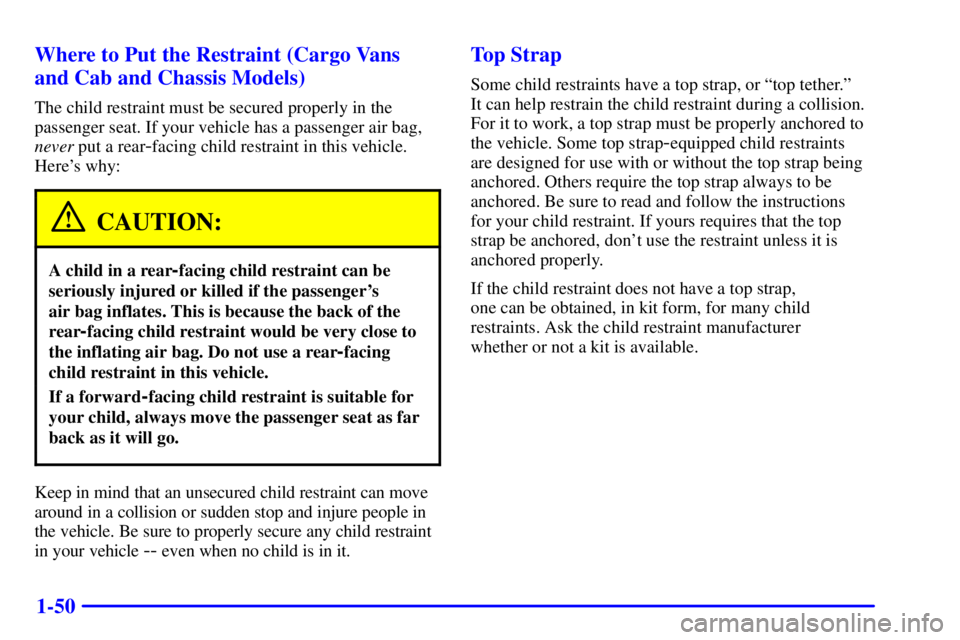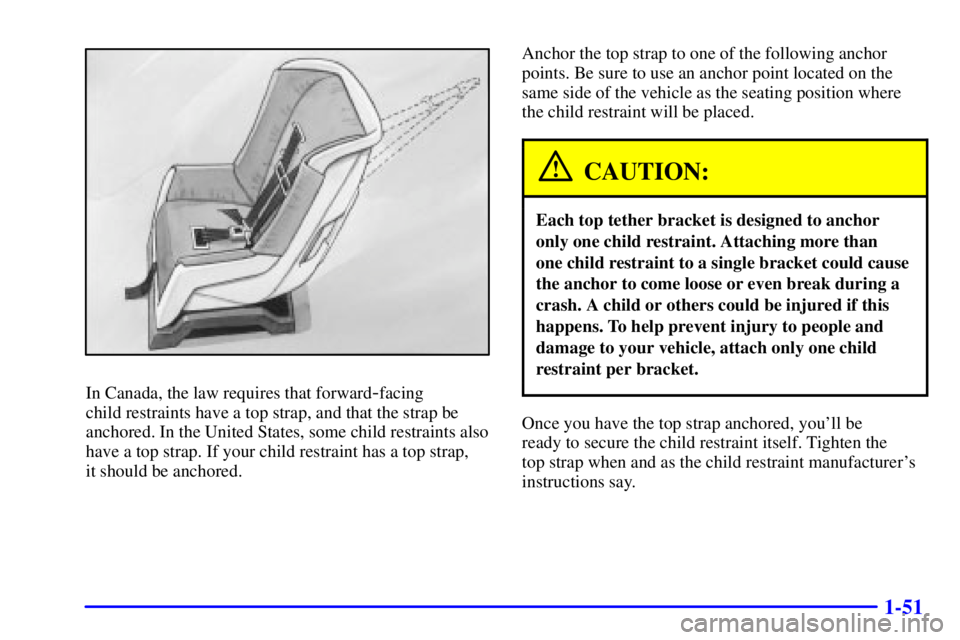Page 56 of 411

1-49 Where to Put the Restraint (Except Cargo
Vans and Cab and Chassis Models)
Accident statistics show that children are safer if they
are restrained in the rear rather than the front seat.
General Motors, therefore, recommends that child
restraints be secured in a rear seat including an infant
riding in a rear
-facing infant seat, a child riding in a
forward
-facing child seat and an older child riding in
a booster seat. If your vehicle has a front passenger
air bag, never put a rear
-facing child restraint in the
front passenger seat. Here's why:
CAUTION:
A child in a rear-facing child restraint can be
seriously injured or killed if the right front
passenger's air bag inflates. This is because the
back of the rear
-facing child restraint would be
very close to the inflating air bag. If your vehicle
has a right front passenger's air bag, always
secure a rear
-facing child restraint in a rear seat.
CAUTION: (Continued)
CAUTION: (Continued)
You may secure a forward-facing child restraint
in the right front seat, but before you do, always
move the front passenger seat as far back as it
will go. It's better to secure the child restraint in
a rear seat.
Wherever you install it, be sure to secure the child
restraint properly.
Keep in mind that an unsecured child restraint can
move around in a collision or sudden stop and injure
people in the vehicle. Be sure to properly secure any
child restraint in your vehicle
-- even when no
child is in it.
Page 57 of 411

1-50 Where to Put the Restraint (Cargo Vans
and Cab and Chassis Models)
The child restraint must be secured properly in the
passenger seat. If your vehicle has a passenger air bag,
never put a rear
-facing child restraint in this vehicle.
Here's why:
CAUTION:
A child in a rear-facing child restraint can be
seriously injured or killed if the passenger's
air bag inflates. This is because the back of the
rear
-facing child restraint would be very close to
the inflating air bag. Do not use a rear
-facing
child restraint in this vehicle.
If a forward-facing child restraint is suitable for
your child, always move the passenger seat as far
back as it will go.
Keep in mind that an unsecured child restraint can move
around in a collision or sudden stop and injure people in
the vehicle. Be sure to properly secure any child restraint
in your vehicle
-- even when no child is in it.
Top Strap
Some child restraints have a top strap, or ªtop tether.º
It can help restrain the child restraint during a collision.
For it to work, a top strap must be properly anchored to
the vehicle. Some top strap
-equipped child restraints
are designed for use with or without the top strap being
anchored. Others require the top strap always to be
anchored. Be sure to read and follow the instructions
for your child restraint. If yours requires that the top
strap be anchored, don't use the restraint unless it is
anchored properly.
If the child restraint does not have a top strap,
one can be obtained, in kit form, for many child
restraints. Ask the child restraint manufacturer
whether or not a kit is available.
Page 58 of 411

1-51
In Canada, the law requires that forward-facing
child restraints have a top strap, and that the strap be
anchored. In the United States, some child restraints also
have a top strap. If your child restraint has a top strap,
it should be anchored.Anchor the top strap to one of the following anchor
points. Be sure to use an anchor point located on the
same side of the vehicle as the seating position where
the child restraint will be placed.
CAUTION:
Each top tether bracket is designed to anchor
only one child restraint. Attaching more than
one child restraint to a single bracket could cause
the anchor to come loose or even break during a
crash. A child or others could be injured if this
happens. To help prevent injury to people and
damage to your vehicle, attach only one child
restraint per bracket.
Once you have the top strap anchored, you'll be
ready to secure the child restraint itself. Tighten the
top strap when and as the child restraint manufacturer's
instructions say.
Page 60 of 411
1-53 Securing a Child Restraint in a Rear
Outside Seat Position
You'll be using the lap-shoulder belt. See the earlier
part about the top strap if the child restraint has one.
Be sure to follow the instructions that came with the
child restraint. Secure the child in the child restraint
when and as the instructions say.
1. Put the restraint on the seat.
2. Pick up the latch plate, and run the lap and shoulder
portions of the vehicle's safety belt through or
around the restraint. The child restraint instructions
will show you how.
If the shoulder belt goes in front of the child's face or
neck, put it behind the child restraint.
Page 62 of 411
1-55
5. To tighten the belt, feed the shoulder belt back
into the retractor while you push down on the child
restraint. If you're using a forward
-facing child
restraint, you may find it helpful to use your knee
to push down on the child restraint as you tighten
the belt.
6. Push and pull the child restraint in different
directions to be sure it is secure.
To remove the child restraint, just unbuckle the vehicle's
safety belt and let it go back all the way. The safety belt
will move freely again and be ready to work for an adult
or larger child passenger.
Page 63 of 411
1-56 Securing a Child Restraint in a Center
Seat Position
You'll be using the lap belt. Be sure to follow
the instructions that came with the child restraint.
Secure the child in the child restraint when and as the
instructions say.
See the earlier part about the top strap if the child
restraint has one.1. Make the belt as long as possible by tilting the latch
plate and pulling it along the belt.
2. Put the restraint on the seat.
3. Run the vehicle's safety belt through or around the
restraint. The child restraint instructions will show
you how.
Page 64 of 411
1-57
4. Buckle the belt. Make sure the release button is
positioned so you would be able to unbuckle the
safety belt quickly if you ever had to.
5. To tighten the belt, pull its free end while you
push down on the child restraint. If you're using
a forward
-facing child restraint, you may find it
helpful to use your knee to push down on the child
restraint as you tighten the belt.
6. Push and pull the child restraint in different
directions to be sure it is secure.
To remove the child restraint, just unbuckle the vehicle's
safety belt. It will be ready to work for an adult or larger
child passenger.
Page 65 of 411
1-58 Securing a Child Restraint in the Right
Front Seat Position
If your vehicle has a front passenger air bag, never put a
rear
-facing child restraint in this seat. Here's why:
CAUTION:
A child in a rear-facing child restraint can be
seriously injured or killed if the front passenger's
air bag inflates. This is because the back of the
rear
-facing child restraint would be very close
to the inflating air bag. If your vehicle is a
passenger van, always secure a rear
-facing
child restraint in a rear seat.
If your vehicle is a cargo van with a right front
passenger air bag, do not use a rear
-facing child
restraint in this vehicle. If a forward
-facing child
restraint is suitable for your child, always move
the passenger seat as far back as it will go.
Although a rear seat is a safer place, you can secure a
forward
-facing child restraint in the right front seat.